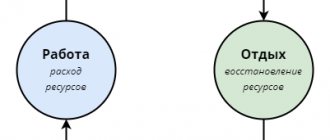Visualization - one of the most common tools of practical psychology. Despite this, or perhaps because of this, many are very skeptical about whether it can positively influence a person’s life.
The concept of visualization is quite simple. You use the power of your imagination to create visions of what you want in life and how exactly you will achieve it. It's like a movie in your head. In our article you will find seven visualization techniques - and if you have never practiced it, you will get a clear idea of what it is and how to use it.
In what cases does it not work? Only when you use it as a magic pill: sit on the couch in front of the TV and imagine how you will achieve success, stand in front of the mirror and convince yourself that you are beautiful and attractive. Visualization always goes hand in hand with great difficulty. It is more of an addition than a tool itself.
How can you use visualization?
The true value of visualization , of course, goes beyond simply increasing your levels of motivation and inspiration. It can be used in a variety of ways to improve many areas of your life. For example, for:
- Achieving goals
- Concentration improvements
- Improvements in learning ability
- Increased self-esteem
- Increased self-confidence
- Decision making improvements
- Changes in values
- Eliminating bad habits
- Letting go of limiting biases
- Mastering a new skill
- Changes in habitual thinking patterns
Later in this article you'll find visualization techniques you can use right now to improve some of these areas. Remember also that a person visualizes almost all his time, but he does it unconsciously. Which in many cases is not very useful. That's why you need to turn off autopilot mode and take matters into your own hands.
Visualization
Basic principles.
Trying to answer this question, let us consider in general what views on the world order exist. Since Ancient Greece, philosophers have been divided into two ideologically opposing camps. The first are convinced of the materiality of the world, assuring others that everything can be explained using the objective laws of nature. The second suggests the presence of a spiritual component, which may be even larger than the reality that we observe and can touch.
This approach is called idealism. Accordingly, visualization can be considered either a product of the human mind or a manifestation of the divine principle. Subjective idealists are convinced that a person can achieve almost anything with the power of thought alone. Objective idealists believe that the intervention of higher powers is necessary, which gives a person what he begins to visualize. In both cases, the algorithm of action is the same: sincere faith and the most clear presentation of the result. And it doesn’t matter so much whether the subconscious will help or someone more powerful. The main thing is that everything will work out.
Do you want to make better decisions, find your ideal career, realize your maximum potential and receive instructions for individual development?
?
All this can be done using the Human Design
. Build your map and get basic decryptions for free.
Regardless of its nature, visualization is based on fundamental laws, the existence of which few doubt. For example, the Law of Feedback , according to which everyone receives what they believe in and lets into their lives. If someone considers others to be evil, only bad people will surround him. Another person, trying to see good qualities in his interlocutors, will subconsciously attract kind and decent people into his environment.
Similarly, this law works when building a career, starting a family, performing at sports competitions and other areas of life. This rule is also called the Law of Attraction , since a person with his thoughts attracts certain events and other people into his life. You can also hear the formulation - the Law of Correspondence, according to which the environment reflects our inner world and our thinking. Visualization of desires works on this principle, but for everything to work, you need to understand its rules.
Take a temperament test
Seven Visualization Techniques
Let's look at seven visualization techniques you can use to improve some aspects of your life, including:
- Learning a new skill
- Improved perception
- Increased self-esteem
- Relaxation of mind and body
- Healing the mind and body
- Statement of action plan
- Achievements of goals
We will now describe the process of all the steps you need to take for each area, and also briefly discuss how using each visualization technique can be useful.
See also: EARTH ANGELS. 6 signs that you are one of them
Visualization for mastering a new skill
The first thing that visualization can be useful is mastering a new area of knowledge. It can be quite effective in this case because the human brain is stimulated in much the same way when we physically perform an action and when we imagine it in our head.
Psychologist Alan Richardson conducted a famous experiment with basketball players, during which it turned out that:
- If you don't practice throwing a basketball hoop for a week, your skill will drop.
- If you visualize (imagine the process in your head) the training, the quality of your throws improves by 23%.
- If you practice, the quality of your throws improves by 24%.
Of course, you can use this visualization to master any skill, but it is important to use all your senses when visualizing.
Here are five simple steps to help you do this.
Step one. Choose a specific skill that you would like to learn.
Step two. Determine your actual level of proficiency in this skill.
Step three. Visualize the process of practicing this skill in vivid detail, using all your senses.
Step four. Repeat this process for 20 minutes daily. The course must last 11 days or more.
Step five. Practice this skill in real life and evaluate your progress. If you are not satisfied with the results, continue the visualization while physically exercising.
Concept
Visualization is the translation of mental ideas into visual images, when a person consciously imagines a desired situation or object for the purpose of its physical embodiment.
In simple terms, it is a means of achieving goals through the use of the power of imagination. For example, you dream of going to London. For effective visualization, you need to imagine not only the image of Big Ben, but also mentally live through the actions that you will take to see it with your own eyes, supporting all this with your emotions.
More than 100 cool lessons, tests and exercises for brain development
Start developing
It is the emotional representation of the process of realization that distinguishes visualization from simple dreams.
This can be compared to watching a movie, only here you replay it in your head, building plot pictures and experiencing emotions from them.
Visualization to improve perception
Visualization can also be very effective when you want to improve your perceptual and observation skills. This skill is of great value because it helps improve your understanding of the people and situations in which you find yourself. Moreover, it pumps up your memory.
Here's a step-by-step process for this kind of visualization.
Step one. Sit in a quiet place and spend a few minutes just observing the world around you.
Step two. Now close your eyes and recreate the world around you in as much detail as possible in your imagination. Make sure to pay special attention to the subtle details, colors and textures of everything you observed in the first step.
Step three. Repeat the process until you can recall every detail of your surroundings.
Of course, once will not be enough. This kind of visualization should become a daily practice: after a while you will become a more observant and receptive person. Too easy and simple? Yes, like everything ingenious. Don't think that these skills require a ton of installed apps on your phone. This exercise is enough.
Another variation of this visualization technique is to take 15-20 minutes at the end of the day to reflect on your entire day from waking up until now.
See also: NEW AGE as a subculture
Increased self-esteem
Whether you lack confidence or suffer from low self-esteem, you can use visualization as a tool to feel better in both respects.
Just three steps.
Step one. Close your eyes and imagine that you are standing in a large empty room.
Step two. One by one, visualize people entering this room. They come up to you and either congratulate you and compliment you or acknowledge your work and efforts.
Step three. When a room is full of people, visualize yourself telling everyone about your accomplishments. Be sure to thank them for their support and valuable feedback.
Of course, you can modify this visualization method by introducing famous people or mentors into the room. You can also imagine people giving speeches about how much they appreciate you. And, of course, it's all in the little things. Surprisingly, the details that make you unique help just as much.
Increasing self-confidence and self-esteem is a very slow process, but with enough persistence you can reduce the amount of time. Practice for 10 to 20 minutes every day and you will gradually begin to feel that you have the strength to change yourself and your life.
Remember, everything is always changing. And either you will change yourself consciously, or you will unconsciously let it take its course. Only effort can lead to success.
Formation of neural connections
The visualization technique works not only at the level of imagination. Very real processes are involved here - neural connections. But they are not formed independently and arbitrarily. You are responsible for their creation and destruction. To be more precise – your thoughts.
Imagination creates a signal in a specific part of the brain. It could be a picture, a video, or a feeling. At first, your request is simply recorded, but nothing more. With constant and repeated repetition of a signal, that is, the same image, a neural connection is formed. Not right away, not as quickly as you want, but it works. The clearer and more specific your thought, the faster the formation of a neural connection.
After its formation, the signal enters space. Thus, you have sent a request to fulfill your desire. You may not notice, but the Universe will begin to unfold events in your life in such a way that it will lead you to your plans.
A strong and persistent neural communication signal requires energy. What is this? That's right, your emotions. They give a powerful impetus to the implementation of your bold ideas.
Relaxation of mind and body
Visualization can be very effective when you are under stress. Whenever you are under pressure, you can use it to calm your body and mind.
Step one. Sit or lie down in a quiet place where there are no distractions. You can play some calm music in the background, which will help you enter a deep relaxing state.
Step two. Breathe deeply and start counting down from 50 to 1. As you do this, you need to gradually relax every muscle in your body from head to toe.
Step three. Once you are completely relaxed, take your imagination to your personal sanctuary. There you will find everything that makes you feel calm, serene and happy.
Once you are in this personal sanctuary, you can direct your visualization in several directions. To begin with, you can simply enjoy the peace and harmony of the moment. Or use this space to reaffirm your goals, values, and priorities. Perhaps there is a person waiting there who is an authority for you? Talk to him about your problems and discuss solutions.
There are no limits to your imagination. You can use your shelter in a variety of ways.
Useful materials on the topic
Here I will leave for you lists of various books, films and courses on the topic of visualization.
Movies:
- The Secret, 2006. Genre: documentary.
- Shrouded in Mystery 2: Down the Rabbit Hole, 2006. Genre: documentary, drama.
- Dreams come true, 2013. Genre: biography, comedy.
- Ruby Sparks, 2012. Genre: fantasy, melodrama.
Books:
- Joe Dispenza “The Power of the Subconscious, or How to Change Your Life in 4 Weeks”
- John Kehoe “The subconscious can do anything”
- Shakti Gawain “Creative Visualization”
- Margarita Murakhovskaya “The Magic Diary of Desires”
- Joe Vitale “Awakening Consciousness. 4 steps to the life you dream of”
- Joseph Murphy “The Power of Your Subconscious Mind.” How to Get Everything You Ask for"
- Esther and Jerry Hicks “The energy of desire that changes the world. Law of Attraction"
- Elizaveta Volkova “Power in Thought. How to fulfill your cherished desire in 30 days”
Courses:
- How to Fulfill Desires - free video course by Igor Bibin.
- Intensive “The Influence of Thought” - video lectures from Veronica Romanovskaya, an expert on working with destructive beliefs. Cost – 5,900 rubles.
And to enhance the effect, I advise you to perform the practice to the sounds of music for visualization.
Healing the mind and body
Over the years, science has repeatedly proven that there is a connection between the body and mind. This connection has been described in many scientific studies where placebos are used instead of drugs, when instead of a real drug a person receives a very similar drug that has neither positive nor negative effects. Sometimes a placebo works just as well.
How is this possible? Essentially, we convince ourselves that something will help us (belief system), and then the brain releases the corresponding chemicals and neurotransmitters that activate the healing process.
Of course, there is also the opposite effect, which is called nocebo. The situation is very similar to a placebo, only the patient suffers some harm to the body. Again, our belief system and brain play a major role here in creating this effect.
Try these three methods to see the value of self-hypnosis.
See also: The best tongue twisters for developing diction
Earth Energy Visualization
Close your eyes and feel yourself standing firmly on the ground (or Earth). Imagine energy flowing through you and healing your body.
Visualization of the golden ball
The second way is to sit in a quiet place and imagine a golden ball of energy or light surrounding your body. This energy begins as a small speck in the heart chakra, and then with each inhalation and exhalation, it gradually grows and expands until it envelops the body.
Fireball visualization
The third method is used to effectively manage pain. Calm your breathing and sit down. Close your eyes and begin to focus on the area of your body where you feel discomfort or pain. Visualize this area as a large, bright, red fireball. Then gradually, with each exhalation, the fireball becomes smaller and smaller until it becomes a small spot on your body. As the fireball contracts, your pain subsides.
You can, of course, use each of these methods in combination, or creatively explore other visualization techniques for pain or for healing. There are many possibilities here that you could explore.
Statement of action plan
If you ever feel stressed or tense, visualizing an action plan can help you calm down, focus, and take action.
This method is best used at the end of the day to plan the next day's work. However, it can also be used during the day when you have about 10 minutes.
This visualization consists of three steps.
Step one. Quiet your mind and just relax. Sitting is probably a good idea as it will help you take a mental break from what you are doing.
Step two. Close your eyes and begin to visualize exactly what you would like to accomplish for the rest of the day (or tomorrow). Visualize this in great detail and ask yourself the following questions:
- What exactly do I want?
- How do I want to feel?
- What specific actions do I want to take?
- How will I interact with other people?
- What obstacles will I have to overcome?
- How can I overcome these obstacles?
- What do I ultimately want to achieve?
It is important that you fully visualize your answers to these questions. Don't stop with the first answer that comes to mind. Actually, here you will see how prone we are to living on autopilot.
The more answers you come up with, the better you will be able to see what mistakes you made before. Pay attention to every detail.
Step three. The reality of life is that, unfortunately, we cannot predict everything that happens to us. Unexpected events often disrupt our plans. However, good planning is not about being precise and inflexible. Rather, it is an adaptation to the circumstances that arise in life.
See also: NLP for beginners. Where to start learning NLP - books and tips
With this in mind, it is important when completing a visualization to affirm that everything will change in one direction or another. By affirming this, you keep your mind open to possibilities. As a result, you'll be ready to make adjustments when unexpected obstacles come your way.
No, this process certainly does not provide a foolproof plan, but what this visualization does help with is imagining possible scenarios that could take place. By introducing them, you will be able to make better decisions while completing your projects and tasks.
The secret to achieving your goal
Surely, each of us has often noticed that some people quickly achieve their goals, while others can live with a utopian dream all their lives without ever realizing it.
What is the secret of successful people? Four components:
- The power of your desire;
- The power of your intention. Your intention determines the Goal.
- Faith;
- Your ultimate goal. When visualizing, it is very important to see your end goal (result).
True self-confidence allows everyone to easily achieve peace of mind and focus on their desires. Believing in the magical fulfillment of desire will speed up the process of implementing your plans. Unfortunately, these four critical steps cannot be learned instantly. This is a great work of consciousness that will require you to work on it every day.











